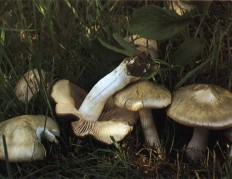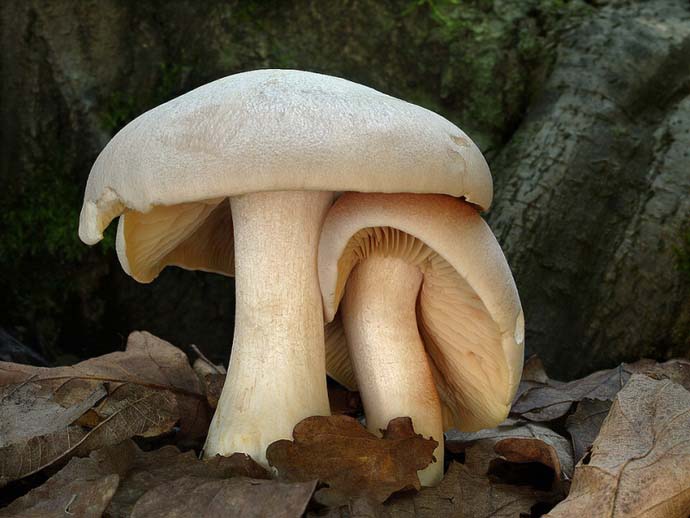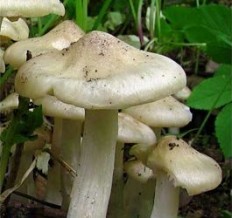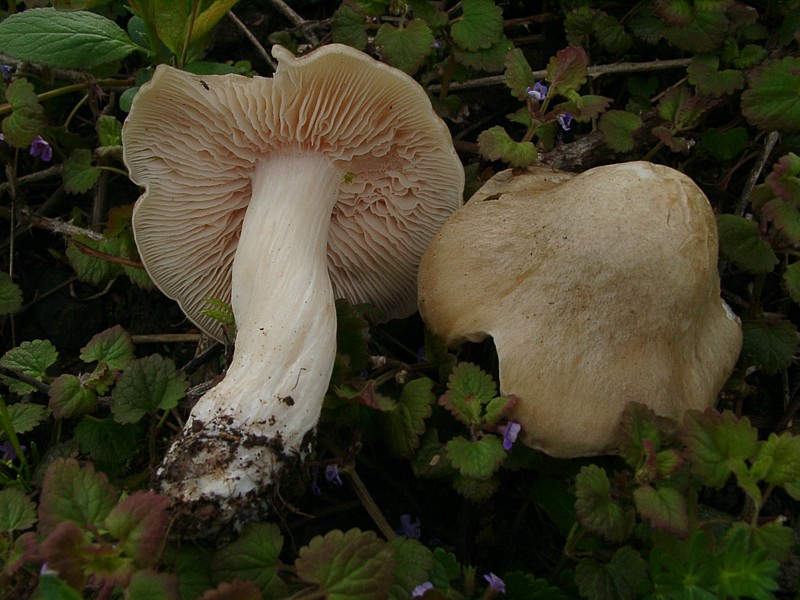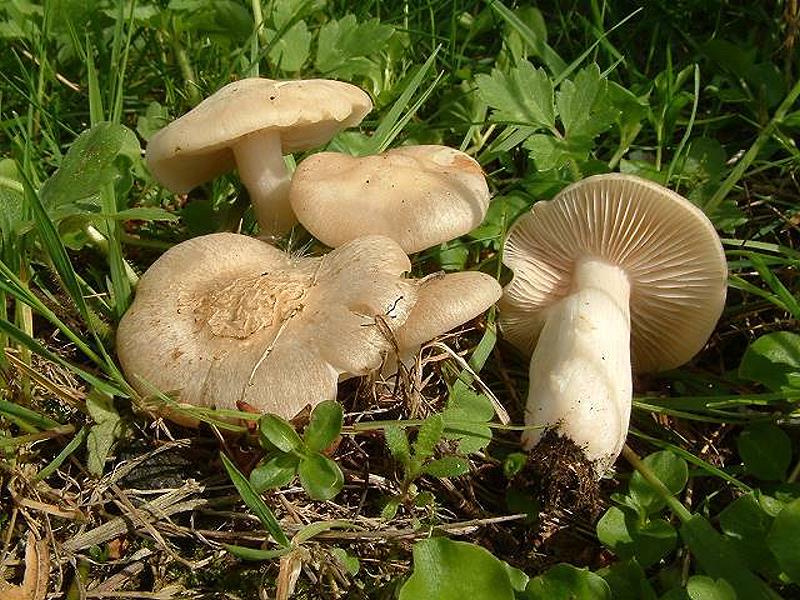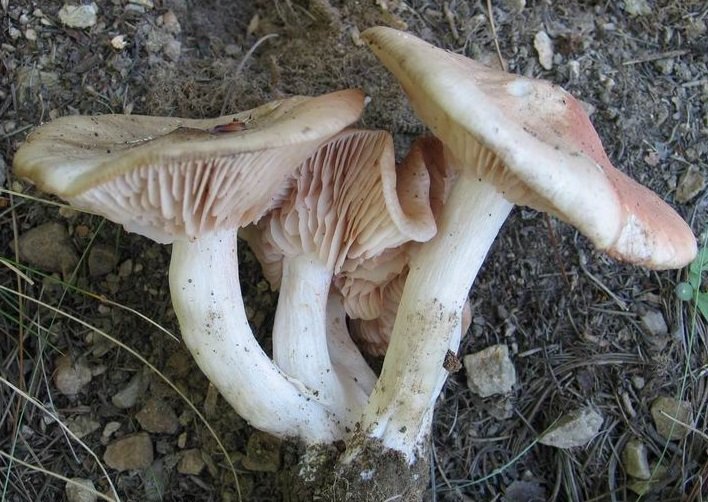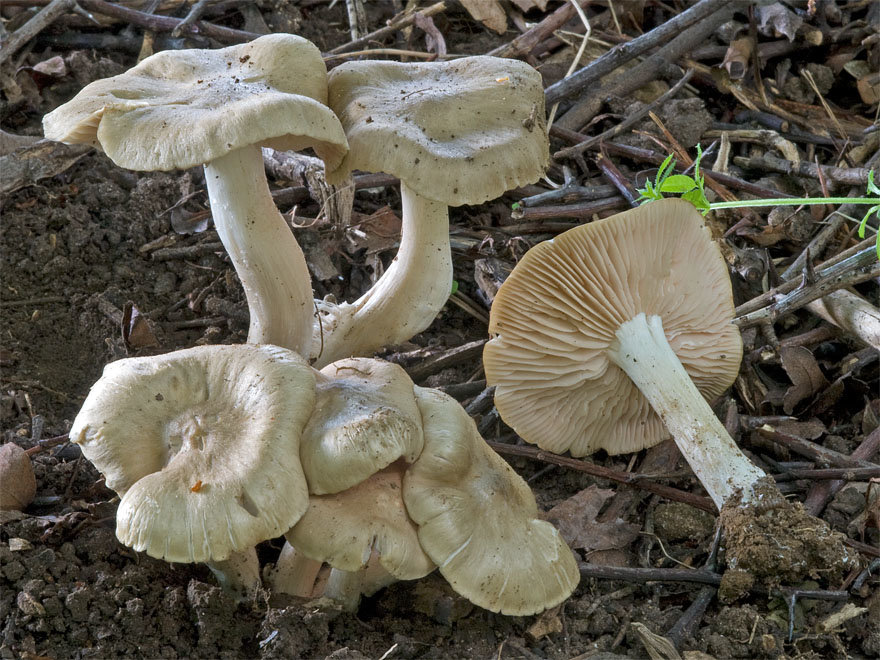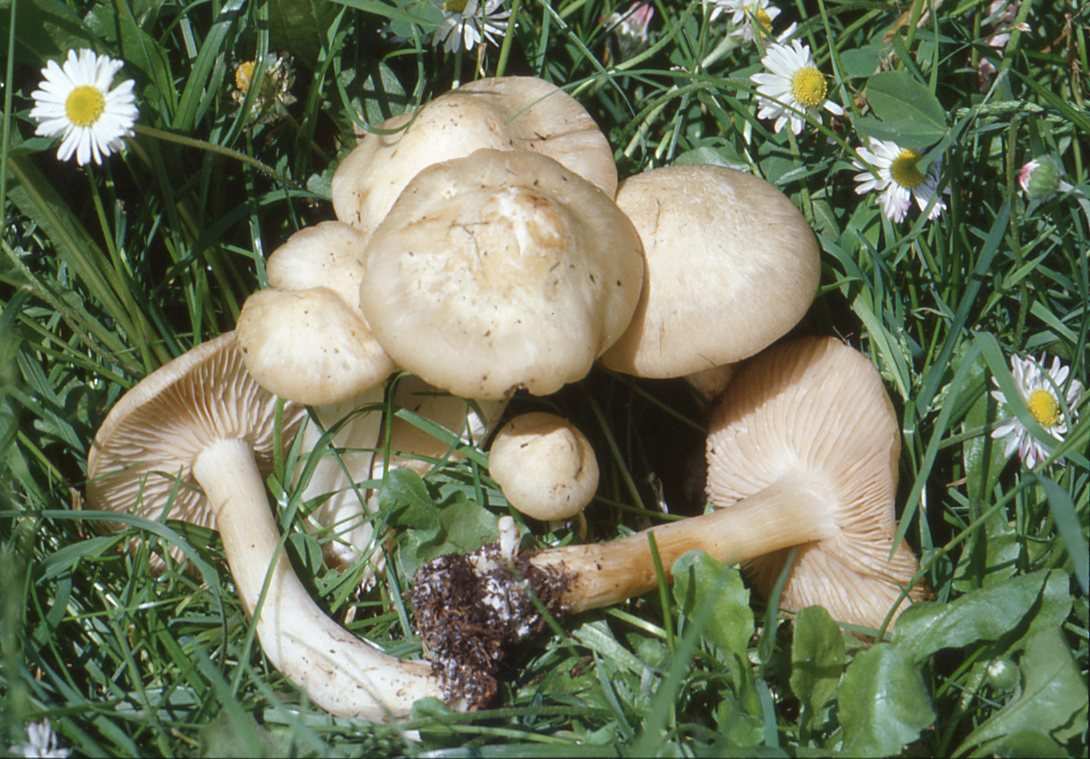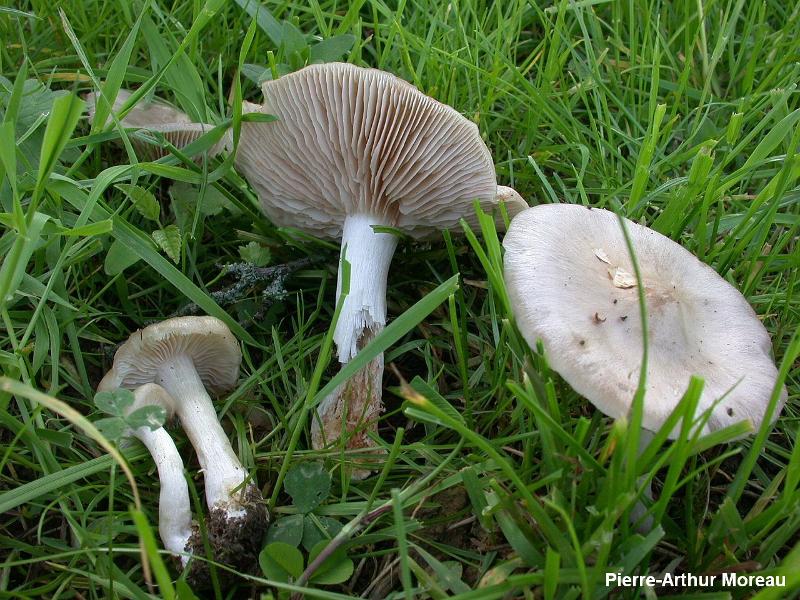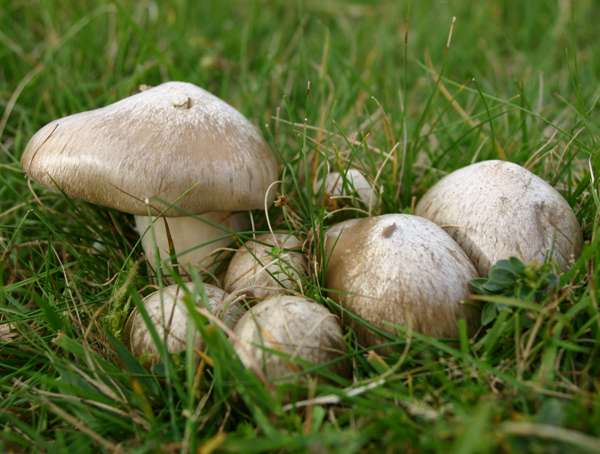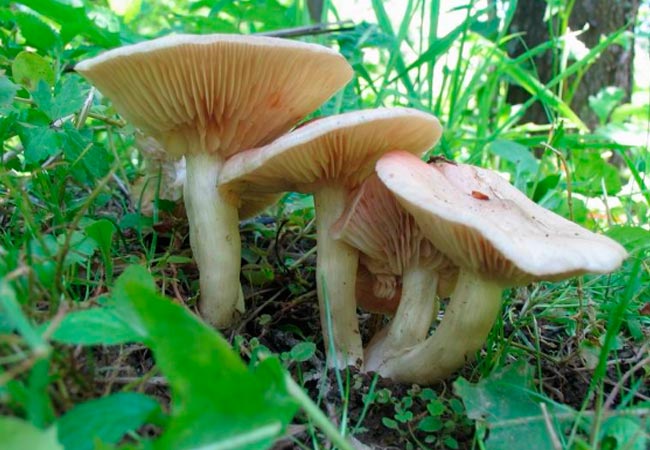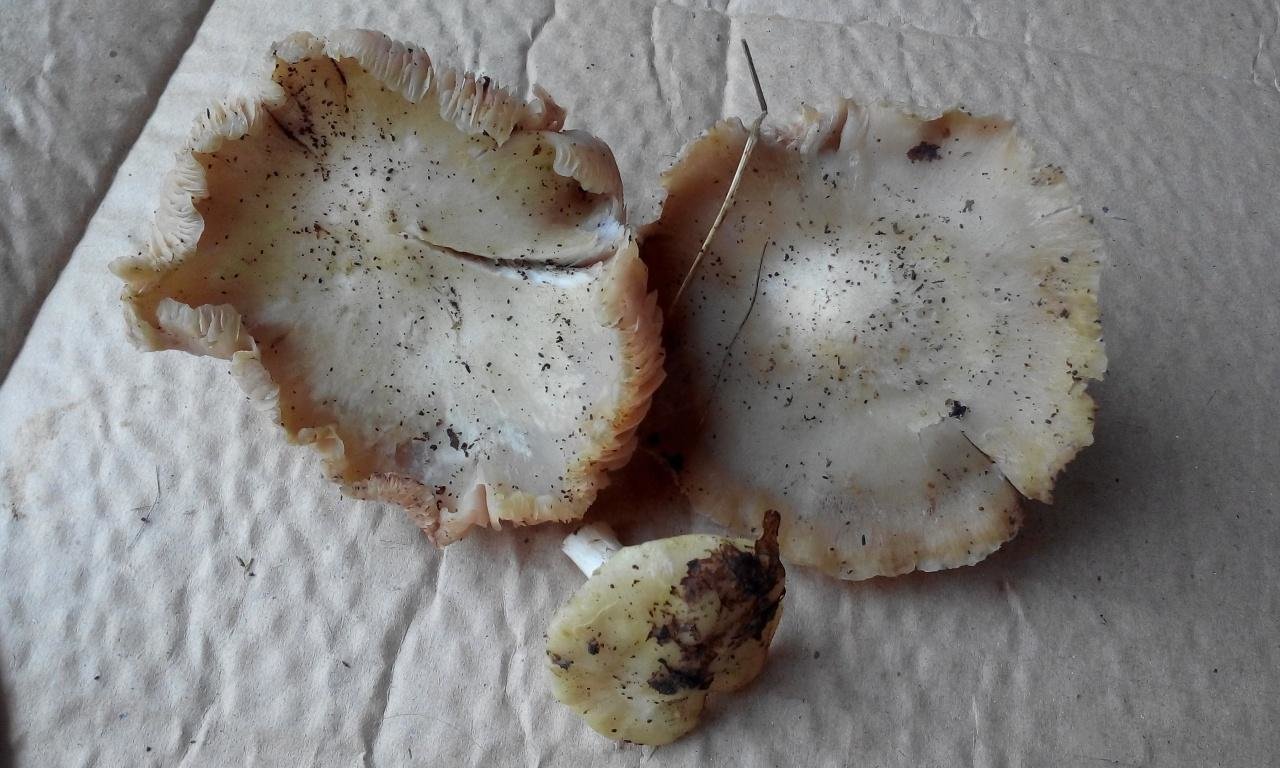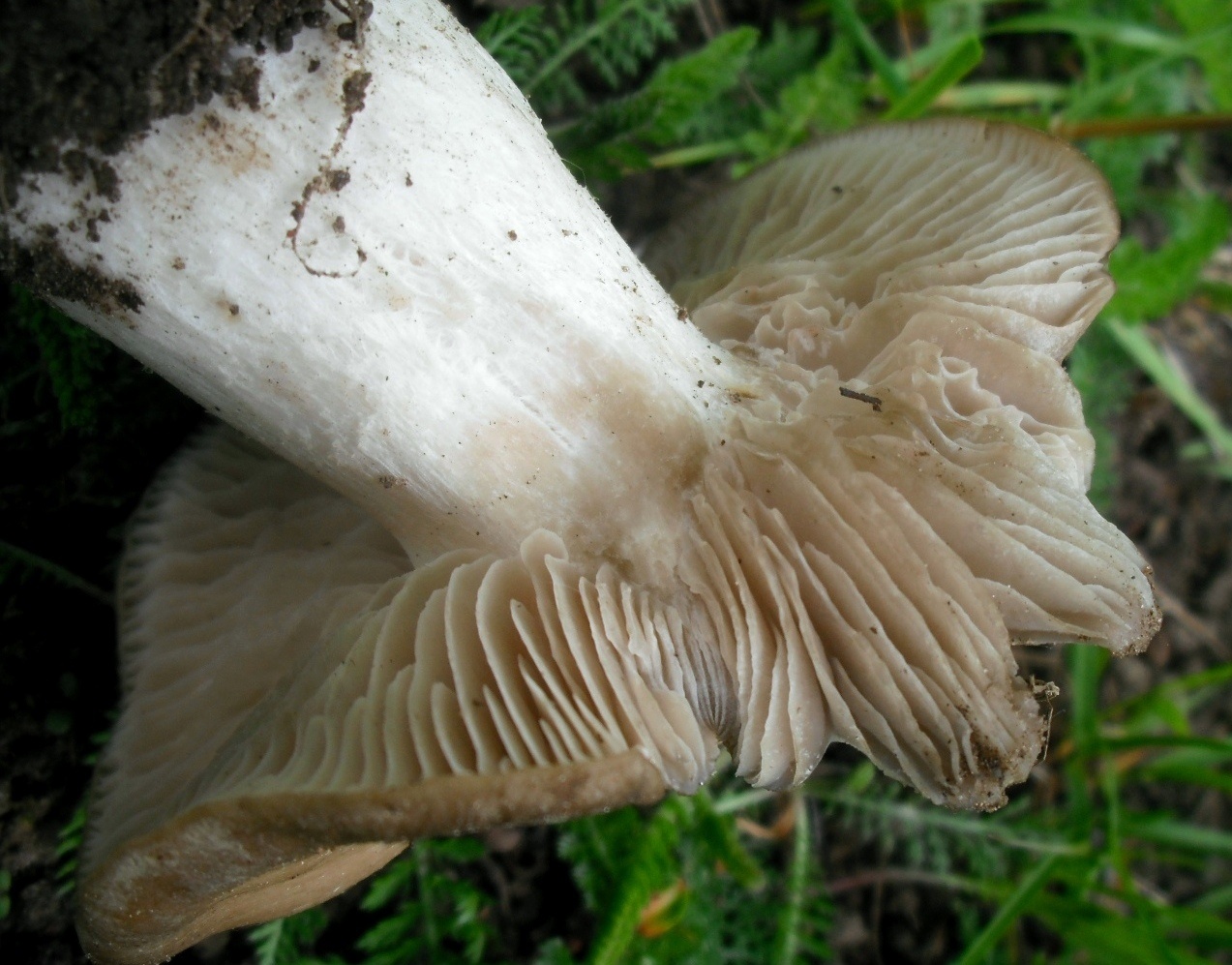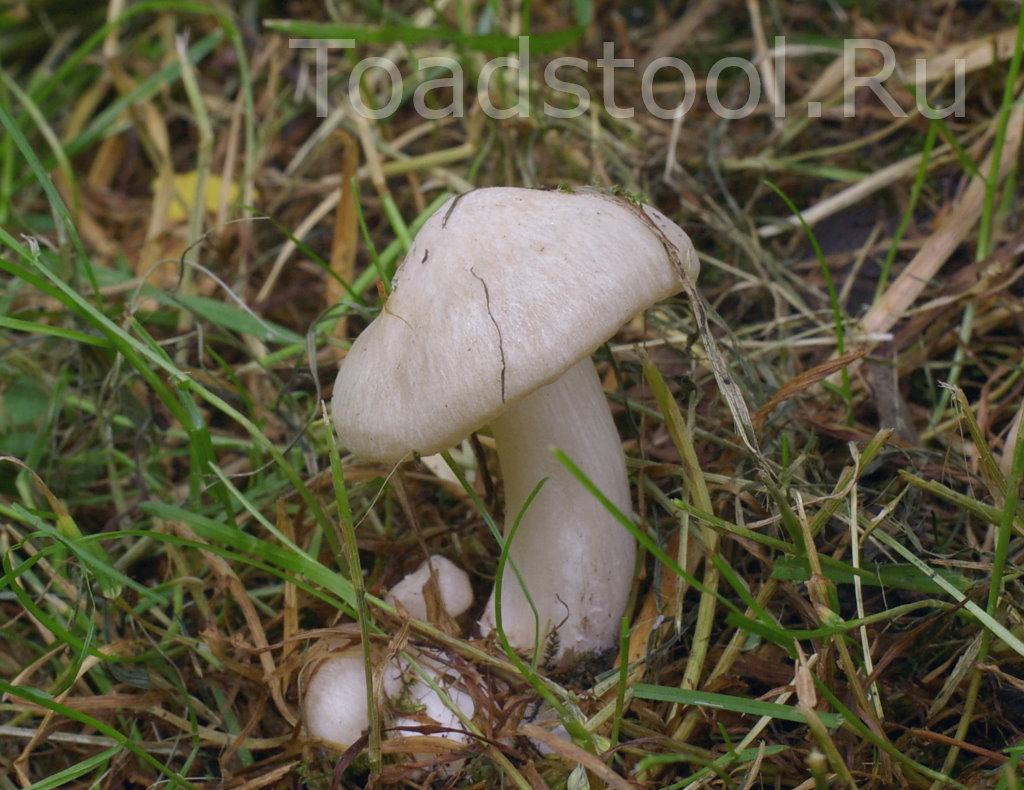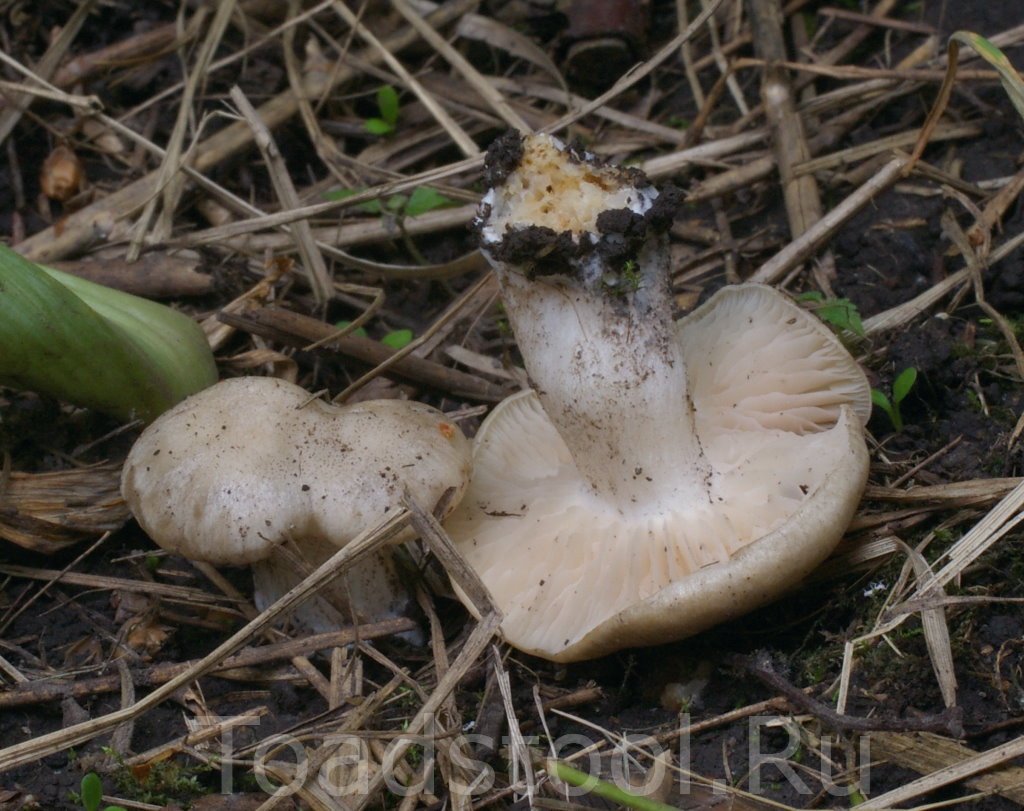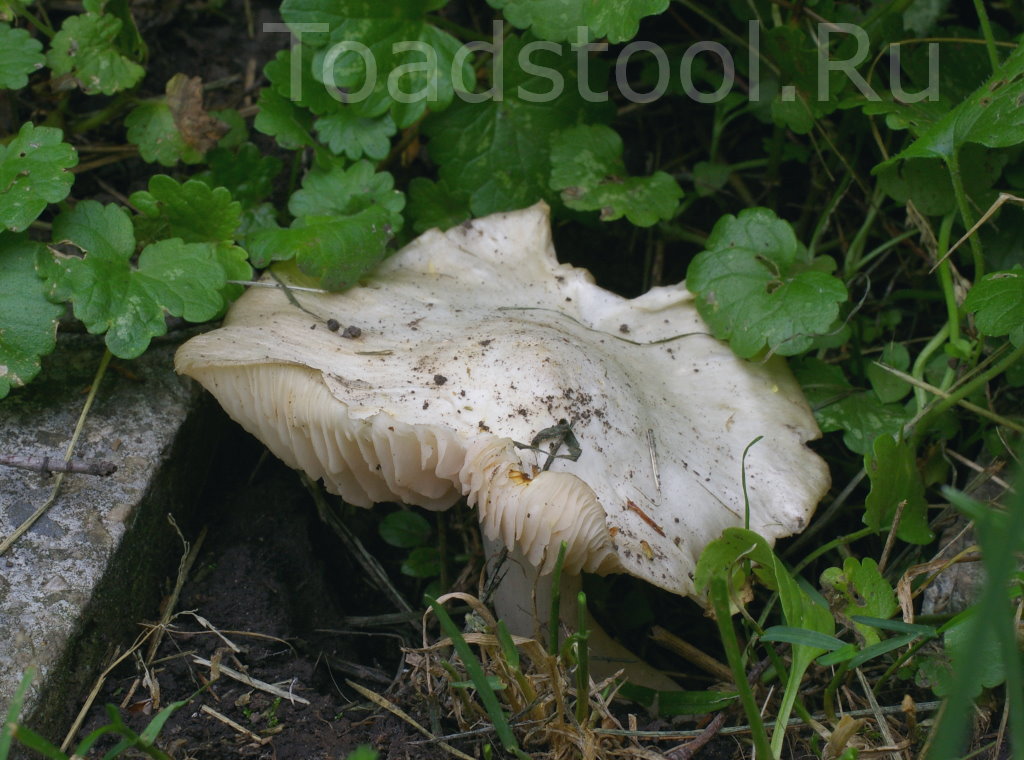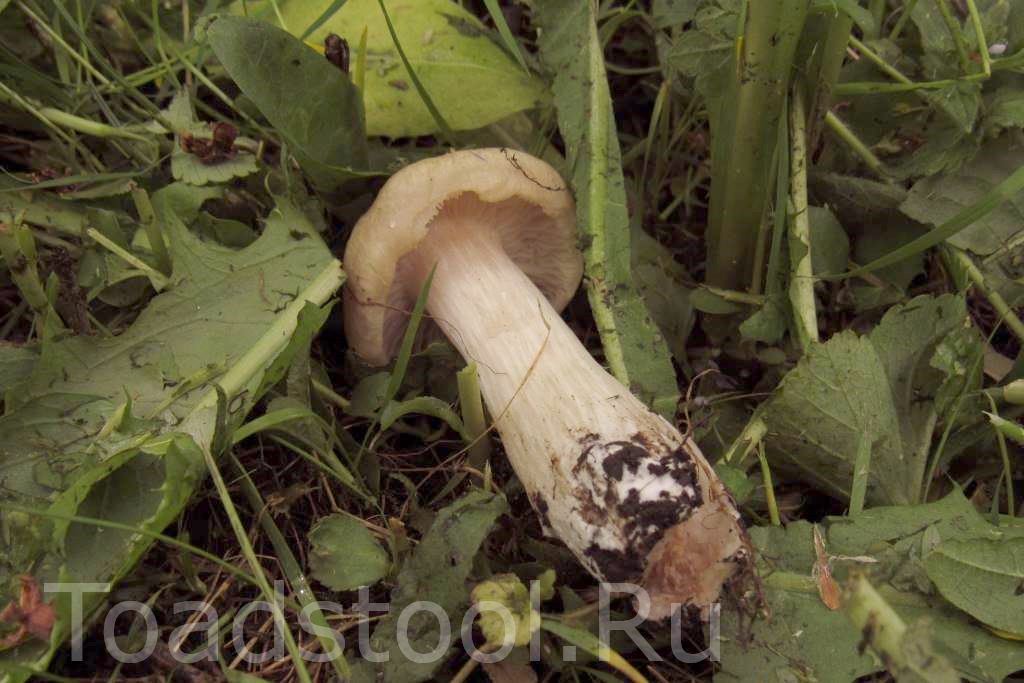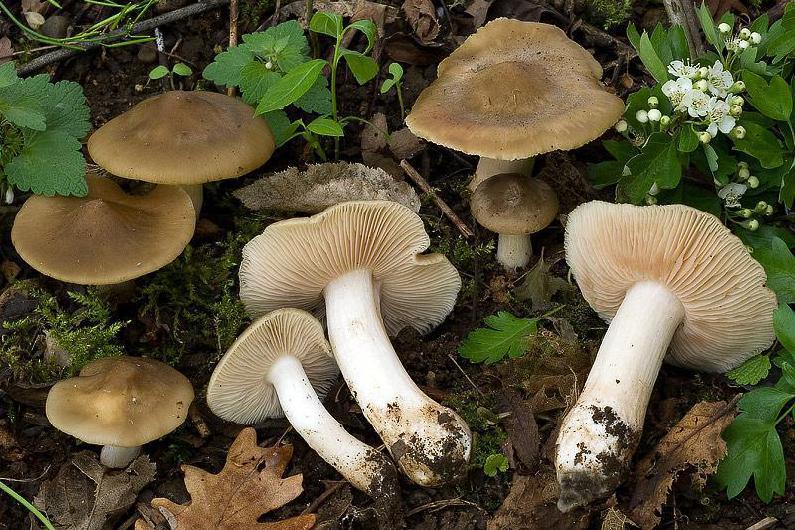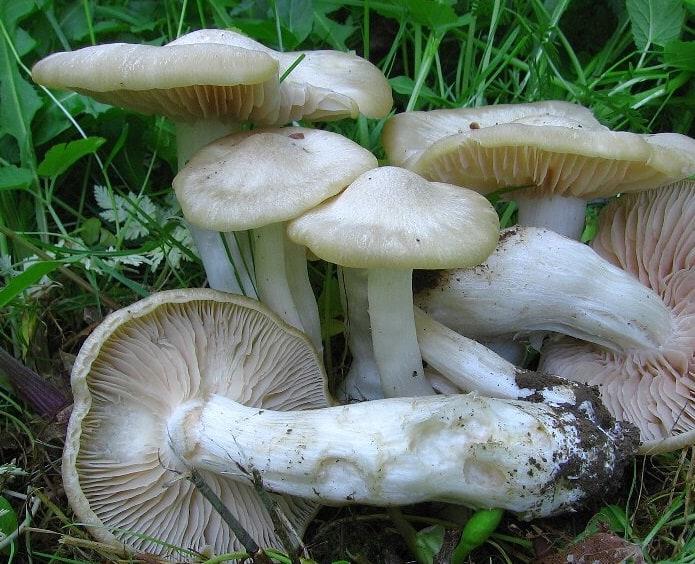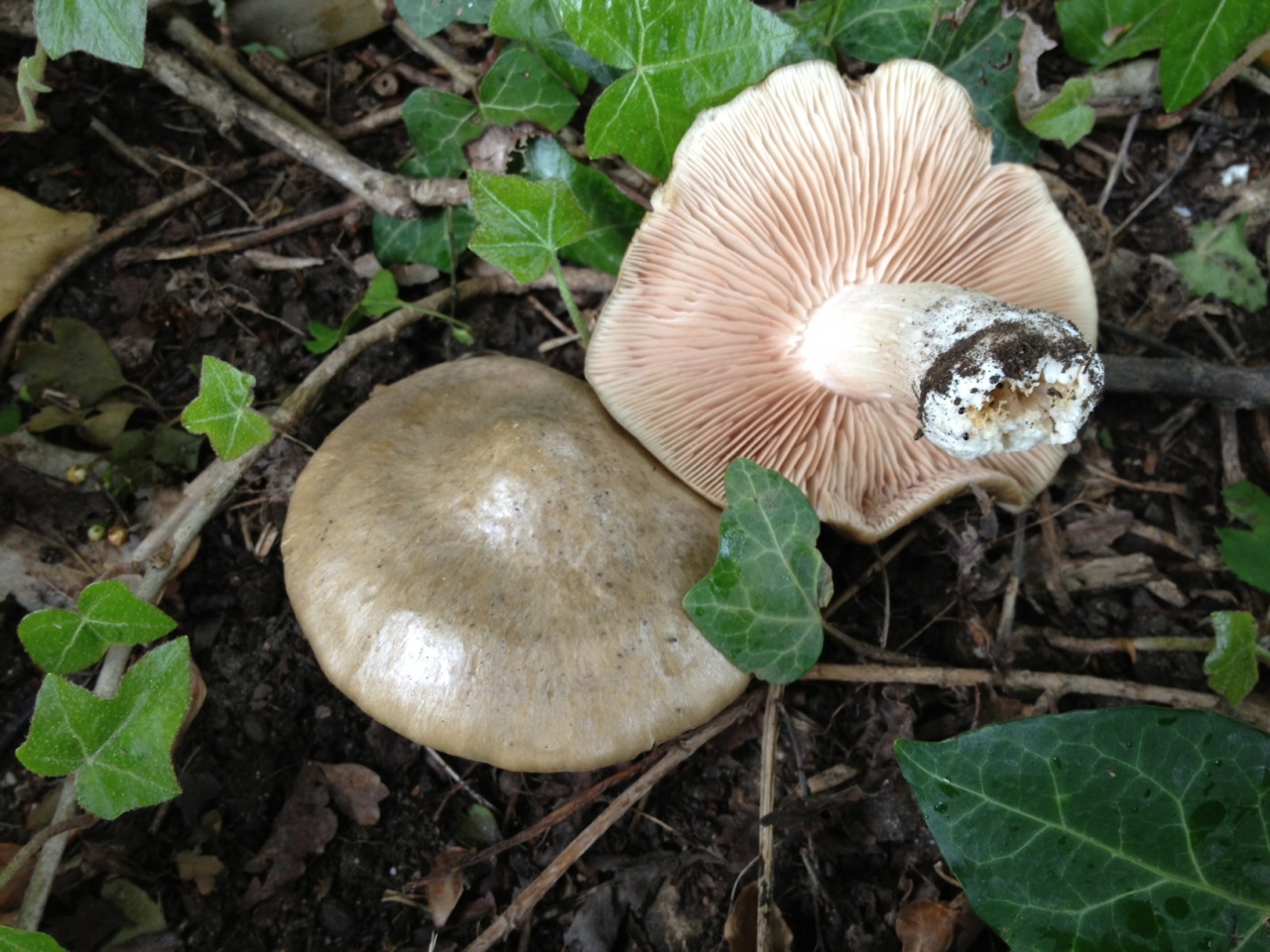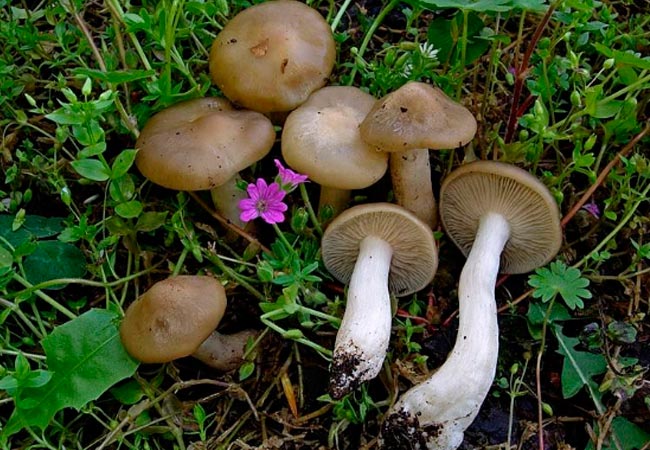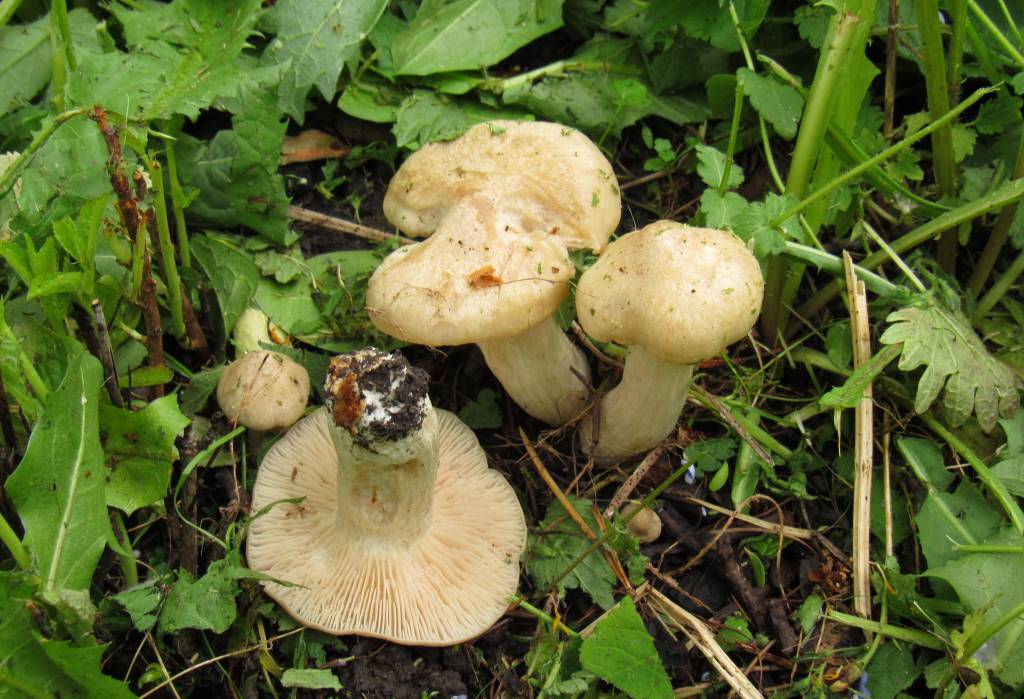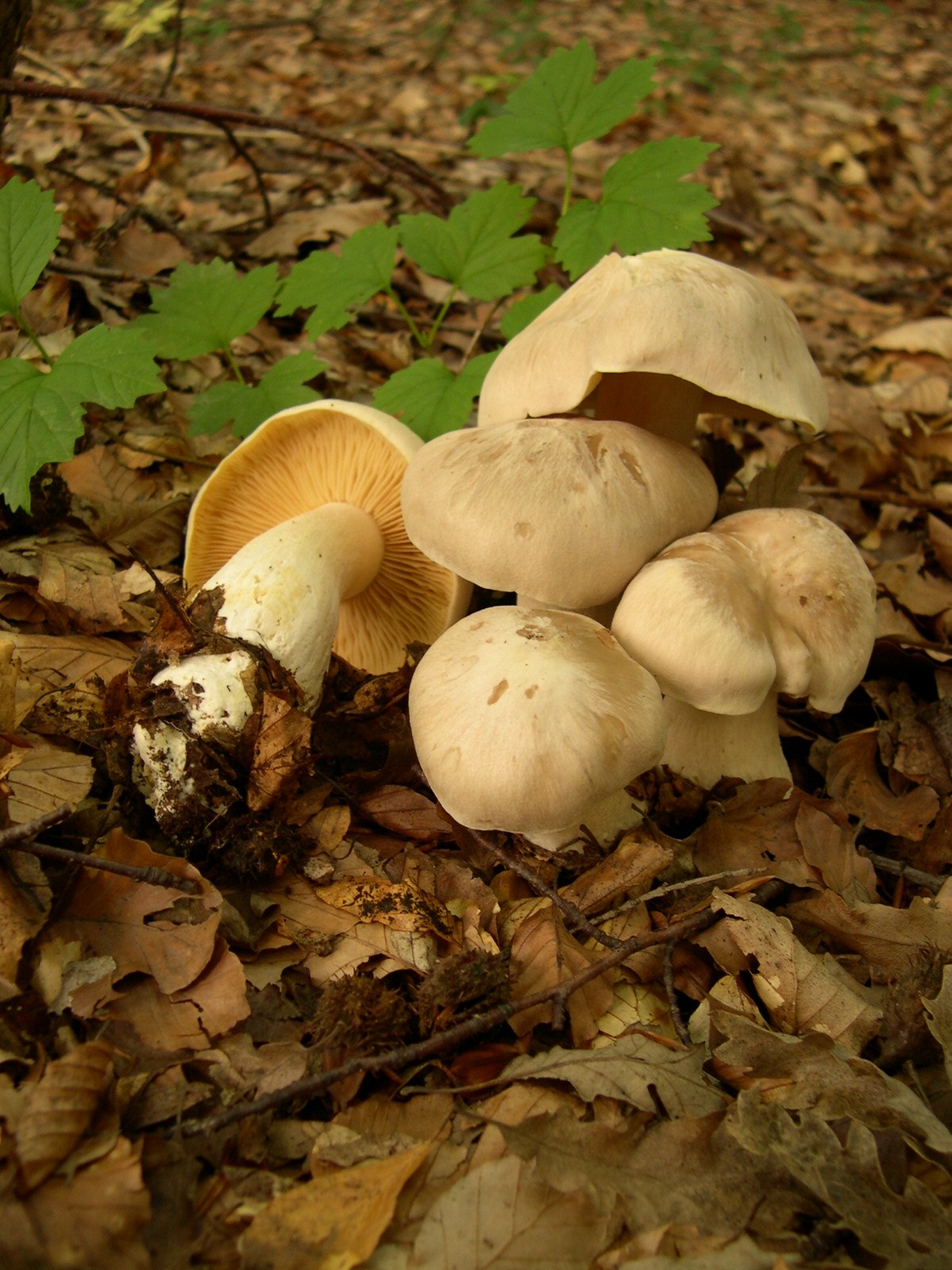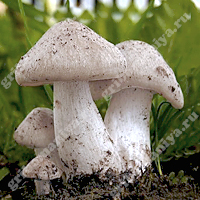Entoloma light brown (Entoloma sepium)
Entoloma light brown - lat. Entoloma sepium
In a different way, this mushroom is called Ternovik, Entoloma sepium, Poddyuchnik or Pale brown Entoloma.
Mushroom cap
Ternovik builds on a rather large hat with a diameter of 30-150 mm. Young hats are made in the form of a flat cone, more mature hats are transformed into wide cones or spread out. In the middle, a non-steep, often flattened mound is formed.
In dry weather, the skin on a fine-stapled hat remains silky - dry and light, in wet weather it becomes sticky and darker. It is colored in yellowish, gray-brown and brownish-yellow tones.
The hats are filled with a tasteless, tight, whitish pulp that exudes a pleasant aroma of fresh flour.
The bottoms of the hats are covered with broad, descending mid-range plates. Young Entoloma sepium has white plates, an adult mushroom is creamy pink, overripe specimens are pink-brown.
Pale brown entoloma reproduces by rounded-angular reddish spores contained in pink spore powder.
Stipe
The cylindrical fibrous stalk of Podoruchnik reaches 8-20 mm in thickness and 30-150 mm in length, and can be bent. The legs of young mushrooms are filled with pulp, which disappears as they mature.
The smooth surface of the legs is white or cream-white.
Entoloma light brown - lat. Entoloma sepium
Growing places
Entoloma light brown prefers mountain slopes, ravines, gullies, and is found under park and garden plantings. It grows abundantly where plum, cherry-plum, apricot, hawthorn and thorn trees and shrubs grow. The mushroom is harvested on Kazakh soil; it also inhabits the Western Tien Shan.
Fruiting of Entoloma sepium occurs in scattered clusters from the last days of April to the end of June. In warmer regions, the mushroom begins to bear fruit from mid-April.
Edibility
Pale brown entoloma belongs to conditionally edible mushrooms: it can be fried, used as a side dish, pickled and salted. The main thing is to boil the mushrooms for 20 minutes in salted water before cooking, and drain the broth.
According to gourmets, the most delicious Entoloma sepium comes from pickling.
Notes (edit)
- Vasilyeva L.N. Agaric cap mushrooms (por. Agaricales) of Primorsky Territory. - L.: Nauka, 1973 .-- P. 256.
- P. M. Kirk, P. F. Cannon, D. W. Minter, J. A. Stalpers. Ainsworth & Bisby's Dictionary of the Fungi. - 10th ed. - CAB International, 2008. - P. 237. - ISBN 978-0-85199-826-8.
- ↑ Bas, C .; Kuyper, T. W .; Noordeloos, M. E .; Vellinga, E. C .; Crevel, R. van; Arnolds, E. J. M. Flora Agaricina Neerlandica. - 1988. - Vol. 1.
- P. F. Cannon, P. M. Kirk. Fungal Families of the World. - CAB International, 2007. - P. 116-117. - ISBN 978-0-85199-827-5.
- Wasser S.P. Flora of mushrooms of Ukraine. Amanital mushrooms / otv. ed. K. A. Kalamees. - TO.: Naukova Dumka, 1992. - S. 41-87. - ISBN 5-12-003226-5.
- ↑ M. E. Peterson, P. A. Talcott. Small Animal Toxicology. - 2nd ed. - Elsevier Health Sciences, 2006. - P. 876. - 1190 p. - ISBN 0721606393.
- J. F. Ammirati, J. A. Traquair, P. A. Horgen. Poisonous Mushrooms of the Northern United States and Canada. - University of Minnesota Press, 1985. - P. 312-313. - 396 p. - ISBN 0816614075.
- E. R. Boa. Champignons Comestibles Sauvages. - Rome: Organization des Nations Uniens pour L'Alimentation et L'Agriculture, 2006. - Vol. 17. - ISBN 92-5-205157-0.
- Roody, W. C. Mushrooms of West Virginia and the Central Appalachians. - University Press of Kentucky, 2003. - P. 133-134. - ISBN 0813190398.
- Nilson, S., Persson, O. Fungi of Northern Europe 2: Gill-Fungi. - Penguin, 1977. - P. 98. - ISBN 0-14-063006-6.
- Fries, E. M. Systema Mycologicum. - 1821. - Vol. 1. - P. 207.
- Fries, E. M. Epicrisis Systematis Mycologici. - 1838.
- Quélet, L. Enchiridion Fungorum in Europa media et praesertim in Gallia Vigentium. - 1886 .-- P. 57.
Biological description
The fruiting bodies of the cap-pectus, small, medium or rather large, are gasteroid in only some species. The type of development of fruiting bodies is hymnocarp, that is, there are no particular and general covers.
The cap is conical, bell-shaped, flat, plano-convex, convex or funnel-shaped, thin or fleshy. The surface of the cap is smooth, velvety or scaly. An important sign for the distribution of species into subgenera is hygrophilousness, that is, the ability to absorb water in wet weather, or non-hygrophilousness of the cap. In representatives of some subgenera, the edge of the cap is translucent and radially lined, while in others it is smooth and opaque.
The plates are adherent or narrowly adhered to the pedicle, descending onto it or with indentations and teeth running down onto the pedicle, only in some species almost free from it. The edge of the plates is even or slightly serrated. In addition to the plates, many species have plates.
The stem is absent or present, central or eccentric, short and fleshy, or thin and long, even or widening towards the base. The surface of the leg is smooth, velvety or finely scaly, striped in some species.
Angular spores of lead-white entoloma
The hyphal system of the fruiting bodies is monomytic, that is, the fruiting bodies of the entolome consist only of generative hyphae. Hyphae with or without buckles, non-amyloid.
Spore powder of pink or pinkish-brown color. Spores in all species are angular, thin or thick-walled. Basidia are two- or four-spore. Cheilocystids - cystids located at the edges of the plates - are most often present, pleurocystids, that is, cystids on the surface of the plates, are absent in most species. The cuticle of the cap (pileipellis) in different species has a different structure: it can be cutis, trichodermis or hymenodermis. Hyphae with or without buckles. Short (30-100 μm), swollen or cylindrical hyphae are characteristic, for example, of the subgenus Entoloma, long fusiform hyphae - for Nolanea... The tram of the plates and the cap is correct, that is, their hyphae are almost not intertwined, but are located parallel to each other.
Similar species from other genera
Fruiting bodies of many entoloms resemble representatives of other, sometimes unrelated genera. One of these genera is Plyutey (Pluteus) from the Plutey family (Pluteaceae). However, representatives of this genus are markedly different from entola - their pinkish plates are always free from the stem. Representatives of some related genera are also outwardly similar to entolomes. For some clitopiluses (Clitopilus) are characterized by descending plates and the absence of cystids, as in many enthol. Some species form mycorrhiza. In other representatives of this genus, previously isolated in the genus Rhodocybe (Rhodocybe), plates adhered to the pedicle or descending to it, the cap is depressed in the center. However, representatives of all these genera are very different from enthol in the form of spores - unlike angular spores with entol, in representatives of these genera they are round, oblong, warty or striped.
Poisonous entoloma (rose leaf), its differences from other mushrooms
At the time of the mushroom "hunt" sometimes there are cases of poisoning with the gifts of the forest. The fact is that some poisonous mushrooms are very similar to edible ones. These include the poisonous entoloma - the largest representative of its family. Its fibers contain a strong poison that can be fatal without proper help.
The appearance of the mushroom
The poisonous lamellar mushroom entoloma, a description of which was first given by H. Person in 1801, is rather large. Usually the cap reaches a diameter of 6-16 cm, in rare cases - 25 cm.
At an early stage of development, the color of the cap ranges from off-white to gray with a touch of ocher. By old age, the color changes towards darker shades and becomes gray-brown. The cap is smooth to the touch; large specimens have small folds in its center.
When wet, the surface of the cap becomes sticky and shiny; when it dries, the shine remains.
In youth, the cap has a hemispherical shape, which, with age, becomes a bell with the edge wrapped around the leg. In old mushrooms, a notch appears on the cap in the center.
Red trellis mushroom: edible or not
The distinctive features of poisonous entoloma include the following:
- the flesh does not change color at the break;
- rare and wide plates;
- the smell of a young mushroom is mealy, with age it becomes rancid.
Distribution and places of growth
Poisonous entoloma, or poisonous rose leaf, is a relatively thermophilic mushroom.Distributed in the southern regions of Russia, comes across in the Caucasus, is well known to the inhabitants of Ukraine and the Republic of Belarus. This mushroom is rarely found in Karelia and the Murmansk region. In Western Europe, it practically does not occur - it is very rarely found in Austria and the mountainous regions of France.
He loves the neighborhood of hornbeam, beech, oak, sometimes it can be found near a willow or birch. Grows, as a rule, in small groups of 2-4 pieces. Favorite growing places are in the shade, under trees, in beams, on swampy soils with a high lime content.
Similar species
There are many edible mushrooms that are similar in appearance to the poisonous rose leaf, which poses a danger to novice mushroom pickers. Most often, fans of "mushroom hunting" confuse entoloma with the following mushrooms:
- pendant - the color is almost identical, the difference is in the plates descending to the leg;
- smoky ryadovka - differs in smaller plates, the color of which is noticeably lighter;
- pigeon ryadovka - differs in a hat, on which colored spots are noticeable, and flesh turning pink on the cut;
- smoky talker - it has a peculiar floral or putrid smell, the plates are narrower and lighter;
- common champignon - is distinguished by the presence of a ring on the leg and dark-colored plates;
- rose-leaf garden - an edible mushroom that grows in gardens and meadows, differs in that its cap has a hygrophilous property (swells when wet).
Edible and Poisonous Species of the Yellow Spiderweb Mushroom
Entoloma poisoning and treatment
When eating even a small piece of this poisonous mushroom, irritation of the gastrointestinal mucosa and intoxication of the body occurs with the following symptoms: severe migraine, vomiting, pain and cramps in the abdomen, diarrhea, dizziness. Signs of poisoning appear within 30-120 minutes.
Inpatient treatment usually lasts no more than 3-4 days. It is carried out permanently in the clinic with the intake of toxin-removing drugs. Glucose and saline are injected intravenously through a dropper.
First aid for poisoning before the arrival of an ambulance consists in washing the stomach, taking sorbents and laxatives.
If chills are observed, the victim should be wrapped in a blanket, blanket or additionally put on warm clothes.
Calling an ambulance is mandatory, you cannot try to cure the poisoning yourself. It is advisable to collect the remains of the mushrooms for transfer for examination to determine the type and degree of toxicity. In severe cases, a blood transfusion is required to save lives after entoloma poisoning, which can only be done in a clinical setting.
After providing first aid and carrying out the entire complex of medical procedures, a poisoned entoloma poisonous may for some time (1-2 weeks) experience deviations from the norm in the state of the body: frequent migraines, increased irritability, severe thirst and indigestion. In this case, it is recommended to take as much fluids as possible to remove toxins from the body.
Galerina edged mushroom: description and differences from honey agarics
Definitioner
- Basidia (Basidia)
-
Lat. Basidia. A specialized structure of sexual reproduction in fungi, inherent only in Basidiomycetes. Basidia are terminal (end) elements of hyphae of various shapes and sizes, on which spores develop exogenously (outside).
Basidia are diverse in structure and method of attachment to hyphae.
According to the position relative to the axis of the hypha, to which they are attached, three types of basidia are distinguished:
Apical basidia are formed from the terminal cell of the hypha and are located parallel to its axis.
Pleurobasidia are formed from lateral processes and are located perpendicular to the axis of the hypha, which continues to grow and can form new processes with basidia.
Subasidia are formed from a lateral process, turned perpendicular to the axis of the hypha, which, after the formation of one basidium, stops its growth.
Based on morphology:
Holobasidia - unicellular basidia, not divided by septa (see Fig. A, D.).
Phragmobasidia are divided by transverse or vertical septa, usually into four cells (see Fig. B, C).
By type of development:
Heterobasidia consists of two parts - hypobasidia and epibasidia developing from it, with or without partitions (see Fig. C, B) (see Fig. D).
Homobasidia is not divided into hypo- and epibasidia and in all cases is considered holobasidia (Fig. A).
Basidia is the place of karyogamy, meiosis and the formation of basidiospores. Homobasidia, as a rule, is not functionally divided, and meiosis follows karyogamy in it. However, basidia can be divided into probasidia - the site of karyogamy and metabasidia - the site of meiosis. Probasidium is often a dormant spore, for example in rust fungi. In such cases, probazidia grows with metabasidia, in which meiosis occurs and on which basidiospores are formed (see Fig. E).
See Karyogamy, Meiosis, Gifa.
- Pileipellis
-
Lat. Pileipellis, skin - differentiated surface layer of the cap of agaricoid basidiomycetes. The structure of the skin in most cases differs from the inner flesh of the cap and may have a different structure. The structural features of pileipellis are often used as diagnostic features in descriptions of fungi species.
According to their structure, they are divided into four main types: cutis, trichoderma, hymeniderma and epithelium.
See Agaricoid fungi, Basidiomycete, Cutis, Trichoderma, Gimeniderm, Epithelium.
- Cutis
-
The type of cap skin, consists of creeping non-gelatinized hyphae located parallel to the surface. The surface of the cap looks smooth.
Lat. Cutis.
See Gifa.
Similar types of mushrooms
There are edible and inedible varieties of mushrooms quite similar to Entoloma clypeatum. Among the edible mushroom species, the pale brown entoloma, or Entoloma sepium, is of particular interest. This mushroom has a creamy, brownish-gray or grayish-brownish-green cap with the presence of emarginate-descending plates and white, with a shiny surface, long-fibered stem type. The edible species Entoloma sepium, which is similar to the creeper, most often grows on the lawn and garden areas, as well as under shrubs from the last decade of May to mid-June.
It is important to note that in addition to the edible species of entoloma, poisonous or tin entoloma grows on the territory of our country. The main, very characteristic feature of the poisonous Entoloma sinuatum is its larger cap.
The average diameter of the cap of an adult mushroom often reaches 18-19 cm. The surface of the cap is off-white, creamy gray, grayish ocher and yellowish. There is a removable skin and yellowish, rather thick plates. The leg is club-shaped, of the same color as the cap. The pulp has a not very pronounced, but weak odor.
In addition, in our country, there can be found not very common, but, nevertheless, highly poisonous species, including entholoma squeezed or Entoloma rhodopolium, which has a thin yellowish-creamy, gray or brownish cap and ammonia aroma. It grows from the last decade of summer to a steady autumn cold snap. The inedible spring entoloma is characterized by a darker coloration of the fruiting body, small size and slender stalk.
Entoloma garden (Entoloma clypeatum)
Podzherdelnik
DESCRIPTION: The hat of an entoloma garden with a diameter of 7 to 10 (and even 12) cm. dry weather - silky fibrous, lighter. Its edge is uneven (wavy), sometimes with cracks.
The color of the cap varies from whitish-gray, beige and gray-brownish to grayish and gray-brown. The plates of the entoloma are wide, rather rare, adherent to the pedicle with a tooth, with a serrated edge, of unequal length.
In adolescence, entolomas are whitish, then they become pale pink, dirty pink or gray-brownish, and in old age they acquire a reddish tint. The pinkness of the plates is the main distinguishing feature of all enthol.A cylindrical, often curved, often twisted leg reaches a height of 10, sometimes 12 cm, in thickness - from 1 to 2 (and even 4) cm.It is brittle, longitudinally ribbed, solid, in old age, hollow, sometimes twisted, slightly under the cap furrowed.
The leg is whitish, pinkish or grayish in color. And its slightly thickened base is lighter. The ring on the leg is always missing. The pulp of entoloma is dense or soft, fibrous, white or brownish, with a weak mealy taste and smell, or even insipid.
Spore powder of pink color.

HABITAT AND GROWTH TIME: Entoloma orchard grows in deciduous and mixed forests under rowan, birch and oak trees - on nutrient-rich soil, along roads, in meadows, in gardens and on city lawns. In the garden, it often grows under fruit trees (apple and pear) and bushes of roses, rose hips, hawthorns and blackthorns.
It is widespread and common on the territory of the Leningrad region and in St. Petersburg, although it grows pointwise - from the last five days of May to the end of July with the most massive fruiting in June and in a wet, cool summer - and in July. Often it gives not one, but several short layers. Garden entoloma rarely appears alone, usually grows in groups, often in large.
TWINS: There is a very similar mushroom - the edible entoloma (Entoloma sepium) with a creamy, brownish-gray and even gray-brownish-greenish cap, notched-descending plates, white, shiny, long-fibered stem. Grows on lawns, gardens and bushes from late May to June.
The main task is not to confuse these two edible entolomes with Entoloma sinuatum or Poisonous Entoloma. The main differences of E. poisonous: a larger size (a cap up to 20 cm in diameter), a lighter (dirty whitish, creamy gray, grayish ocher and yellowish) cap with an easily removable skin, yellowish (in youth) plates, thicker ( up to 3 cm in diameter), a clavate leg, one-color with a cap, and a faint unpleasant smell of pulp. But this smell can be almost imperceptible. It is not found in the north of Russia.
There are two more relatively similar poisonous entolomes. Entoloma pushed through (Entoloma rhodopolium) with a thin yellow-cream, gray or brownish cap and ammonia odor. It grows from August to early October. And Entoloma spring - darker, shallow, slender and growing from the end of April to the last five days of May, that is, does not overlap with Entoloma Sadovaya in terms of timing.
EATABILITY: This is a conditionally edible mushroom. Boil entoloma for 20 minutes, and then put it in a roast, pickle or pickle. In southern Russia, dishes from it are from the category of traditional mushroom dishes, and in Western Europe, it is considered one of the best mushrooms.
Video about the mushroom Entoloma garden:
NOTES: The word "clypeatum" in the name of the mushroom means "shaped like a shield." Widespread on the globe: Western Europe, Ukraine, European Russia and North America. Appears in warm regions in April. The genus Entoloma has 153 species, among them there are edible mushrooms, but in order to use them for food, you need to be an experienced mushroom picker. The clearest photographs and the best descriptions cannot save you from error, so be careful with these mushrooms!
You don't have to go far for some types of mushrooms - they settle right on summer cottages and backyards. So, garden entoloma brings abundant mushroom harvests under fruit trees and shrubs.
False doubles
Entoloma has a fairly large number of twins. You can clearly see the differences in the photo.
- The pale brown entoloma is also an edible species. It has a similarity to the garden due to the same color of the legs and cap.
- Collectable entoloma - is distinguished by the presence of shiny scales and the fact that the leg expands towards the base.
Dangerous doubles:
| Entoloma poisonous or tin | The main difference is the large cap in comparison with the Podlivnik. Its diameter can reach 2 cm. The skin is easily removable, the plates are yellowish. Has almost no smell.In order to get severe intoxication, it is enough to eat one small piece. The first signs of poisoning appear within half an hour after eating the mushroom. |
| Entoloma squeezed | Differs from the garden fruiting period - from August to October. It can also be distinguished by a pungent ammonia odor. |
| Entoloma spring | It has a fruiting period different from Podlivnik - from April to May. It also stands out for its darker cap color and smaller size. |
Important! Poisoning can manifest itself in a wide variety of symptoms: long-lasting migraines, dizziness, loss of coordination, nausea and vomiting, diarrhea and flatulence, weakness in the body. If, after eating entoloma, at least one of the listed symptoms is observed, an urgent need to consult a doctor
How to distinguish the false counterparts of a poisonous mushroom?
For those who like to walk in the forest, it is important to be able to distinguish edible mushrooms from a poisonous twin. It is better to first familiarize yourself with the photos of representatives of edible and inedible mushrooms
The table below lists the differences between twins from each other.
| Mushroom name | Differences |
Pendant |
Descending hymenophore plates |
Champignon |
Differs in the color of the hymenophore, has a ring on the leg |
Pigeon row |
It has colored spots on the cap; if damaged, a color change to pink is observed. |
May ryadovka |
It has narrow and often spaced plates under the cap. |
Smoky Talker and Tin Entoloma
 Smoky talker
Smoky talker
You can distinguish the Smoky Govorushka from a poisonous twin by narrow, often located plates that are cream or white in color. They descend weakly along the stem and are easily separated from the cap. By smell, Smoky Govorushka stands out with a floral scent. In some cases, there is a distinct rotten smell.
Differences from Entoloma Sadovaya
 Entoloma garden
Entoloma garden
The edible representative of the kingdom of mushrooms, namely, Entoloma garden differs from its poisonous counterpart in that it has a hygrophilous cap, that is, when moisture gets on the fruiting body, it begins to swell. It cannot be found in forest belts, only in meadows or in gardens.



